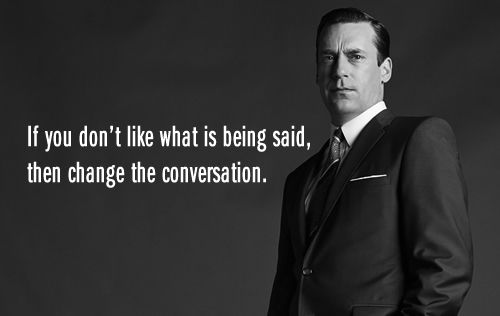Between The Power of Habit and Thinking, Fast and Slow
, my approach to “communication†has changed dramatically.
Communication is about being understood. Period.
Communication is not about simply sending an email, making a quick phone call, or screaming a little louder than everyone else. Communication is about breaking into the behavior loop of your audience, earning their attention, and hopefully affecting some action—no matter how small or large.
The problem? We are set in our ways—deeply set in our ways.
The epiphany for me is that we fly on auto-pilot most of the time and do not take time to hear, internalize, and understand. When it comes to habits, we have a few strikes against us. First, when you really get down to it, learning requires effort, and truth be told, we’re lazy. Second, we hate feeling dumb.
Our brains learn processes, practice them, and then automate them so that our minds can think about more productive things. Disengaging auto-pilot is difficult. When you first started driving, you studied it, took input from others, and were really conscious about driving, but after a while you thought less and acted more automatically–we move from understanding to autopilot. We drive down the road listening to music, talking on the phone, and even occasionally texting. However, as soon as you are navigating a curvy, mountainous road, or driving down the interstate during a monsoon, all your attention goes back into driving. It is no longer automated because these distractions broke into the automatic behavior.
In addition to running on autopilot, when confronted with “new,” people do not like to give the appearance of being dumb. For years, I would test the effectiveness of different web designs in user labs. More than any one takeaway about the designs, my biggest finding was that people don’t want to click on something that they do not understand. We want predictability. We don’t want to feel dumb, so we do things that are safe.
The cause? Disruption abuse.
In addition to being selfish with our attention, we are disruption fatigued. Advertising is built on disrupting us. Inundated with deception and bedazzlement of more than 3,000 advertisements per day, we simply cannot pay attention to every distraction thrown our way. We build filters about what is really important (“Newsworthy†as Ezra Pound says) and what is disruption via deception. An EAS warning on the television notifying me that a tornado is en route is a worthy disruption, another Snuggie commercial is not. The problem is that we see 1000x more infomercials than we do EAS warnings. In the battle of signal to noise filtering, we become fatigued and the default, typically, is that everything is noise except for what I deem to be signal. In fact, I almost “pull†all of my signal and distrust 95% of the push communication.
The solution? Cue the reel Don Draper.

The communicator is in charge of the results of the communication. If your goal is to get your workforce to go to the intranet, sending an organization-wide email is not going to change behavior. For some reason, we think that volleying the task ball over the net is enough. It’s not. Saying, speaking, or sending is not sufficient.
Sometimes you have to change the way you speak to be understood.
Changing human behavior is tough business. I’ve heard that changing one habit may take as long as 18 months, but Charles Duhigg would suggest that the behavior loop can be modified as little as one day if the “rewards†are changed.

“What’s in it for me?†is just another way to say “reward.†Changing the conversation is about understanding what the other person wants to hear, not being bombastic, flashy, or funny. Remember, this is not about merely talking, it’s about being understood, and that requires appealing to the peculiarities of your audience.
Effective communication is measured through action. Are your employees visiting the intranet? Is your customer registering for your webinar? Are you customers using your new iPad app? If your audience understands what you are attempting to communicate and chooses not to act willfully, then you as the communicator have done your job. I would venture to say, however, that most audiences don’t understand why you are disrupting them, what you want them to do, or how they are supposed to do it. Do you talk to your boss the same way you talk to your spouse? Probably not, yet marketers love to “mass†everything from media to mail. As soon as it is sent, we begin measuring results—not necessarily of effect but opens.
Trying to be understood, you may have to dig.
- Get down in the dirt and figure out why you are or aren’t being understood and fix that problem.
- In the famous words of Steve Covey, “seek to be understood.â€
- Understand that volleying the communication over the net is not enough. You’re not done until you are understood.
- Earn some trust with your communication by giving your audience something that makes their lives better.
- Don’t communicate to everyone the same. Segment your communications to people that behave similarly. They don’t have to look alike, but they do need to act alike.
- Add some finesse. Great designers understand more than beauty. They understand function.
I don’t want to change my behavior, but I will. For 15 years, I composed email with a keyboard, until a guy convinced me that I could use a single, all-in-one device. He did not like the conversation of lightweight, flimsy netbooks that were emerging as a most favored device, he said this is the future and things you rely on today will go away. Fast forward five years, Flash is dead and the iPad is the most popular consumer electronic device. The conversation changed, junky netbooks vanished, and consumers clambered for the product.
Do something like that, and I’ll change my behavior.